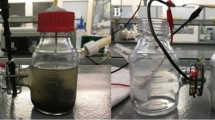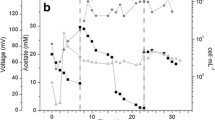Abstract
A fuel cell was used to enrich a microbial consortium generating electricity, using organic wastewater as the fuel. Within 30 days of enrichment the maximum current of 0.2 mA was generated with a resistance of 1 kΩ. Current generation was coupled to a fall in chemical oxygen demand from over 1,700 mg l−1 down to 50 mg l−1. Denaturing gradient gel electrophoresis showed a different microbial population in the enriched electrode from that in the sludge used as the inoculum. Electron microscopic observation showed a biofilm on the electrode surface and microbial clumps. Nanobacteria-like particles were present on the biofilm surface. Metabolic inhibitors and electron acceptors inhibited the current generation. 16S ribosomal RNA gene analysis showed a diverse bacterial population in the enrichment culture. These findings demonstrate that an electricity-generating microbial consortium can be enriched using a fuel cell and that the electrochemical activity is a form of anaerobic electron transfer.







Similar content being viewed by others
References
Allen RM, Bennetto HP (1993) Microbial fuel-cells: electricity production from carbohydrates. Appl Biochem Biotechnol 39:7–40
Anderson RT, Rooneyvarga JN, Gaw CV, Lovley DR (1998) Anaerobic benzene oxidation in the Fe(III) reduction zone of petroleum contaminated aquifers. Environ Sci Technol 32:1222–1229
Bond DR, Holmes DE, Tender LM, Lovley DR (2002) Electrode-reducing microorganisms that harvest energy from marine sediments. Science 295:483–485
Caldwell DE, Korber DR, Lawrence JR (1992) Imaging of bacterial cells by fluorescence exclusion using scanning confocal laser microscopy. J Microbiol Methods 15:249–261
Chang IS, Kim BH, Kim DH, Lovitt RW, Sung HC (1999) Formulation of defined media for CO fermentation by Eubacterium limosum KIST612 and growth characteristics of the bacterium. J Biosci Bioeng 88:682–685
Dolfing J (1996) Degradation of monochlorinated and nonchlorinated aromatic compounds under iron-reducing conditions. Appl Environ Microbiol 62:3554–3554
Eaton AD, Clesceri LS, Greenberg AE (1995) Standard methods for the examination of water and wastewater, 19th edn. American Public Health Association, Washington, D.C.
Gerhardt P (1993) Methods for general and molecular bacteriology. American Society for Microbiology, Washington, D.C.
Haberman W, Pommer EH (1991) Biological fuel cells with sulphide storage capacity. Appl Microbiol Biotechnol 35:128–133
Higgins IJ, Hill HAO (1985) Bioelectrochemistry. Essays Biochem 21:119–145
Jang JK, Pham TH, Chang IS, Kang KH, Moon H, Cho KS, Kim BH (2003) Construction and operation of a novel mediator- and membrane-less microbial fuel cell. Process Biochem (in press)
Kazumi J, Haggblom MM, Young LY (1995) Degradation of monochlorinated and nonchlorinated aromatic compounds under iron-reducing conditions. Appl Environ Microbiol 61:4069–4073
Kim BH, Ikeda T, Park HS, Kim HJ, Hyun MS, Kano K, Takagi K, Tatsumi H (1999a) Electro-chemical activity of an Fe(III)-reducing bacterium, Shewanella putrefaciens IR-1, in the presence of alternative electron acceptors. Biotechnol Tech 13:475–478
Kim BH, Kim HJ, Hyun MS, Park DH (1999b) Direct electrode reaction of Fe(III) reducing bacterium Shewanella putrefaciens. J Microbiol Biotechnol 9:127–131
Kim HJ, Park HS, Hyun MS, Chang IS, Kim M, Kim BH (2002) A mediator-less microbial fuel cell using a metal reducing bacterium, Shewanella putrefaciens. Enzyme Microb Technol 30:145–152
Kim BH, Chang IS, Gil GC, Park HS, Kim HJ (2003) Novel BOD (biological oxygen demand) sensor using mediator-less microbial fuel cell. Biotechnol Lett 25:541–545
Kim TS, Kim BH (1988) Modulation of Clostridium acetobutylicum fermentation by electrochemically supplied reducing equivalent. Biotechnol Lett 10:123–128
Lawrence JR, Korber DR, Hoyle BD, Costerton JW, Caldwell DE (1991) Optical sectioning of microbial biofilms. J Bacteriol 173:6558–6567
Lloyd JR, Sole VA, Van Praagh CVG, Lovely DR (2000) Direct and Fe(II)-mediated reduction of technetium by Fe(III)-reducing bacteria. Appl Environ Microbiol 66:3743–3749
Lovley DR (1991) Dissimilatory Fe(III) and Mn(IV) reduction. Microbiol Rev 55:259–287
Lovley DR, Lonergan DJ (1998) Anaerobic oxidation of toluene, phenol, and p-cresol by the dissimilatory iron-reducing organism, GS-15. Appl Environ Microbiol 56:1858–1864
Lovley DR, Phillips EJP (1986) Organic matter mineralization with reduction of ferric iron in anaerobic sediments. Appl Environ Microbiol 51:683–689
Muyzer G, Waal EC de, Uitterlinden AG (1993) Profiling of complex microbial populations by denaturing gradient gel electrophoresis analysis of polymerase chain reaction-amplified genes coding for 16S rRNA. Appl Environ Microbiol 59:695–700
Myers CR, Myers JM (1992) Localization of cytochromes to the outer membrane of anaerobically grown Shewanella putrefaciens MR-1. J Bacteriol 174:3429–3438
Nealson KH, Saffarini DA (1994) Iron and manganese in anaerobic respiration: environmental significance, physiology, and regulation. Annu Rev Microbiol 48:311–343
Nevin KP, Lovley DR (2000) Lack of production of electron-shuttling compounds or solubilization of Fe(III) during reduction of insoluble Fe(III) oxide by Geobacter metallireducens. Appl Environ Microbiol 66:2248–2251
Newman DK, Kolter R (2000) A role for excreted quinones in extracellular electron transfer. Nature 405:94–97
Park DH, Zeikus JG (2000) Electricity generation in microbial fuel cell using neutral red as an electronophore. Appl Environ Microbiol 66:1292–1297
Park DH, Kim BH, Moore B, Hill HAO, Song MK, Rhee HW (1997) Electrode reaction of Desulfovibrio desulfuricans modified with organic conductive compounds. Biotechnol Tech 11:145–148
Park DH, Laivenieks M, Guettler MV, Jain MK, Zeikus JG (1999) Microbial utilization of electrically reduced neutral red as the sole electron donor for growth and metabolite production. Appl Environ Microbiol 65:2912–2917
Park HS, Kim BH, Kim HS, Kim HJ, Kim GT, Kim M, Chang IS, Park YK, Chang HI (2001) A novel electrochemically active and Fe(III) reducing bacterium phylogenetically related to Clostridium butyricum isolated from a microbial fuel cell. Anaerobe 7:297–306
Pham TH, Jang JK, Chang IS, Kim BH (2003) Cathode reaction in a mediator-less microbial fuel cell with graphite or platinum-coated graphite as the cathode. J Microbiol Biotechnol (in press)
Reimers CE, Tender LM, Fertig S, Wang W (2001) Harvesting energy from the marine sediment–water interface. Environ Sci Technol 35:192–195
Tender LM, Reimers CE, Stecher HA III, Holmes DE, Bond DR, Lowy DA, Pilobello K, Fertig SJ, Lovley DR (2002) Harnessing microbially generated power on the seafloor. Nat Biotechnol 20:821–825
Turick CE, Tisa LS, Caccavo F Jr (2002) Melanin production and use as a soluble electron shuttle for Fe(III) oxide reduction and as a terminal electron acceptor by Shewanella algae BrY. Appl Environ Microbiol 68:2436–2444
Uosaki K, Hill HAO (1981) Adsorption behaviour of 4,4′-bipyridyl at a gold/water interface and its role in the electron transfer reaction between cytochrome c and a gold electrode. J Electroanal Chem 122:321–327
Whitman WB, Coleman DC, Wiebe WJ (1998) Prokaryotes: the unseen majority. Proc Natl Acad Sci USA 95:6578–6583
Acknowledgements
This study was supported by a grant from the Korea Institute of Science and Technology and The Ministry of Science and Technology (Evaluation and Planning under the National Research Laboratory Program) in Korea. Parts of this paper have been presented at the 98th General Meeting of the American Society for Microbiology (poster number I-12).
Author information
Authors and Affiliations
Corresponding author
Rights and permissions
About this article
Cite this article
Kim, B.H., Park, H.S., Kim, H.J. et al. Enrichment of microbial community generating electricity using a fuel-cell-type electrochemical cell. Appl Microbiol Biotechnol 63, 672–681 (2004). https://doi.org/10.1007/s00253-003-1412-6
Received:
Revised:
Accepted:
Published:
Issue Date:
DOI: https://doi.org/10.1007/s00253-003-1412-6




